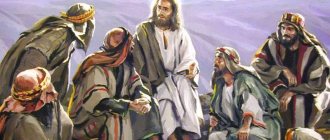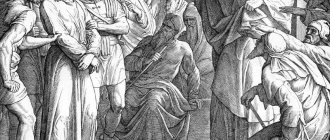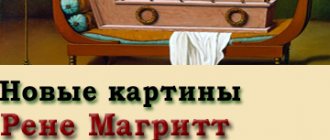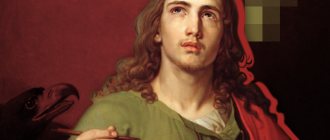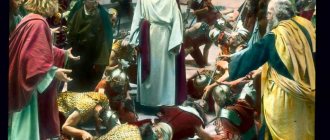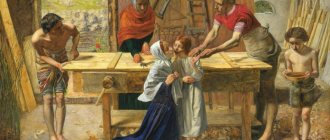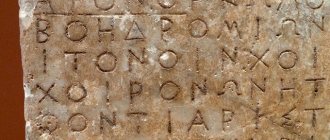Audio version of the article
- Why was the prudent robber pardoned? St. John (Shanghai)
- About the Cross and the Thief St. John (Chrysostom)
- There is no salvation outside the Church. The prudent thief, Deacon Georgy Maksimov
- Does Christ’s salvation of one of the thieves testify to the fact that salvation does not require effort and repentance is quite accessible just before the death of the body? Metropolitan Vladimir (Ikim)
- About the baptism of the Prudent Thief
- An exceptional case as a universal argument K. Borisov
***
The prudent thief is one of the two thieves crucified on Calvary next to Jesus Christ (according to legend, at the right hand of the Savior), who repented, believed in Christ, humbly expressed his faith before Him and received from Him the promise that “now” he will abide with Nim in heaven.
All four evangelists speak in more or less detail about the two thieves crucified with Jesus Christ (Matthew 27:44, Mark 15:32, John 19:18); the most complete account of this is given by the Evangelist Luke (Luke 23:39–43).
The apocryphal Gospel of Nicodemus gives the names of the thieves crucified with Christ. The unrepentant robber, who was to the left of the Savior, was called Gestas. And the other, the prudent thief at the right hand of Christ, is called Dismas. In the medieval Byzantine ancient Russian tradition, a prudent robber is called Rakh.
***
For what crime was the Prudent Thief crucified?
The word thief, used in the Synodal Translation of the Holy Scriptures, also has the meaning of rebel (terrorist). Considering that Judea at that time was occupied by the Roman Empire, such a translation as partisans is also appropriate.
In those days, theft was not punished by crucifixion, so it can be assumed that the robbers crucified next to Christ the Savior waged an armed struggle against the invaders, and did not trade in robbery.
Notes
- Exapostilary before the 9th Gospel
- Consequence of figurative (undefined)
(inaccessible link). Access date: December 8, 2007. Archived February 28, 2008. - Archbishop Averky (Taushev). Four Gospels.
Apostle. A Guide to Studying the Holy Scriptures of the New Testament. Orthodox St. Tikhon's Humanitarian University: Moscow, 2007. ISBN 5-7429-0065-1 - Sermon on Wednesday of the first week of Great Lent at Compline. About repentant crying.
- John Chrysostom. A conversation about the cross and the thief, and about the second coming of Christ, and about unceasing prayer for enemies (unspecified)
(inaccessible link). Date accessed: November 6, 2021. Archived June 18, 2012. - Tuesday of the sixth week of Great Lent (undefined)
(inaccessible link). Access date: February 25, 2008. Archived April 10, 2008. - Saint Theophan the Recluse. “Three words about bearing the Cross.”
- Aristides the philosopher, The Tale of the Prudent Thief
- About patience
- Arabic gospel of the childhood of the Savior. 23.
- ↑ 12
A Word about the Tree of the Cross - V. P. Zverev. Mother of God motifs in the poetic works of F. N. Glinka
- ↑ 12
Gospel of Nicodemus - Krylov N. History of the Cross on which Christ was crucified
. M., 1855. - Socrates Scholastic. Church history
- Christopher E. Abode of the Soaring Cross
// World Pathfinder, 2006 No. 15 - The Walk of Abbot Daniel
- Title from the Life-Giving Cross of the Lord on the website Pravoslavie.Ru
- Socrates Scholastic. Church history
Ch. 17 - ↑ 12
On some features of the iconography of the Crucifixion - St. Dismas at www.catholic-forum.com (unspecified)
(inaccessible link). Access date: December 8, 2007. Archived December 7, 2007. - ↑ 12
The Prudent Robber // Orthodox Encyclopedia - P. G. Chesnokov. “The prudent thief...” (Good Friday chant)
- Order of Liturgy (undefined)
(inaccessible link). Access date: February 23, 2010. Archived August 27, 2009. - Translation: “ I will not reveal secrets to Your enemies, and I will not give You such a kiss as Judas, but like the thief (who repented on the cross) I believe in You.
” - Aristide the philosopher. "The Tale of the Prudent Thief"
- The word of the monk Cyril of Turov about the removal of the body of Christ from the Cross, and about the Myrrh-Bearers (unspecified)
(inaccessible link). Access date: December 8, 2007. Archived November 11, 2007. - The Golden Legend. Henry W. Longfellow (unspecified)
(unavailable link). Retrieved November 26, 2009. Archived December 31, 2008. - N. Leskov “Descent into Hell”
- Site news (inaccessible link) Pravoslavie.Ru
- Anishino.
On the meaning of the penitential feat of the Prudent Robber
Priest Afanasy Gumerov:
A great change took place in the soul of the robber. He turned out to be worthy of heaven. The grace of God healed him, but we should not belittle his personal merit. The converted robber accomplished three feats. First of all, a feat of faith . The scribes and Pharisees, who knew all the prophecies about the Messiah and saw numerous miracles and signs performed by Jesus Christ, turned out to be blind and sentenced the Savior to death. The thief was able to see God incarnate in a man chained, like himself, to a cross and doomed to death. What an amazing power of faith. He also accomplished a feat of love . He died in suffering. When a person is tormented by unbearable pain, he is entirely focused on himself. The former thief, being in such a state, was able to show compassion for Jesus. When another thief slandered Him, he calmed him down and said: “He has done nothing wrong” (Luke 23:41). Do we have so much love for Jesus Christ, who receive so many benefits from God? The prudent robber accomplished the third feat - the feat of hope . Despite such a dark past, he did not despair of his salvation, although, it seemed, there was no longer time for correction and the fruits of repentance.
Content
- 1 Texts 1.1 Gospel description 1.1.1 Interpretation in Christianity
- 1.3.1 Origin of the brigands
- 2.1 The prudent robber Dismas
Legends about the meeting of the Prudent Thief with the Holy Family
There is a later popular legend that it was a prudent robber who saved the lives of the Mother of God and the Baby Jesus on the road to Egypt, when Herod’s servants were killing all the babies in Judea. On the road to the city of Misir, the Holy Family was attacked by robbers with the intention of profiting. But righteous Joseph had only a donkey, on which the Most Holy Theotokos sat with her Son; the possible profit of the robbers was small. One of them had already grabbed the donkey, but when he saw the Infant Christ, he was surprised at the extraordinary beauty of the child and exclaimed: “If God had taken a human body for Himself, He would not have been more beautiful than this child!” And this robber ordered his companions to spare the travelers. And then the Blessed Virgin said to such a generous thief: “Know that this baby will reward you well for preserving him today.” This robber was Rakh.
Another legend conveys differently the meeting of the prudent robber with the Holy Family. E. Poselyanin describes it this way: “Seized by robbers, the travelers were brought to their den. There lay the sick wife of one of the robbers, who had an infant. The mother's illness had a hard impact on the child. He tried in vain to suck a drop of milk from her exhausted breast. The Mother of God saw the suffering of the child, the torment of the unfortunate mother. She walked up to her, took the baby into her arms and put him to her chest. And from the mysterious drop that penetrated the fading body, life instantly returned to the withered child. The cheeks became rosy, the eyes sparkled, and the half-corpse turned back into a cheerful, blooming boy. This was the effect of the mysterious drop. And in this boy there remained for the rest of his life the memory of the wonderful Woman, with whom he, dying, was healed. Life had not been kind to him; he followed the path of crime trodden by his parents, but spiritual thirst, the desire for the best never left this ruined life. (Viller E. Mother of God. Description of Her earthly life and miraculous icons). Of course, this baby turned out to be Rakh.
Iconography
“The Crucifixion”
, Emmanuel Lampardos, 17th century, Cretan school. Hermitage
Art historians note that the robbers on the sides of Christ in scenes of the Crucifixion appeared starting from the 5th-6th centuries (the earliest known image is an icon from the monastery of St. Catherine, dating from the 6th century).
The prudent thief was crucified on the right side of Christ (right hand), so the Savior’s head is often written inclined in this direction. This indicates his acceptance of a repentant criminal. In Russian icon painting, the inclined crossbar under the feet of Jesus is also usually directed upward towards the Prudent Thief. The prudent robber was written with his face turned to Jesus, and the Mad Thief was written with his head turned away or even his back turned.
Artists sometimes emphasized the difference between Jesus and the thieves on either side of him, as well as the difference between the two criminals:
| Jesus Christ | Robbers | |
| cloth | loincloth | perizoma |
| cross | Life-giving cross, clear geometric shapes | ugly, wild, crooked trunks, T-shaped cross |
| fastening | nails | tied with ropes |
| hands | straight, elongated | tied behind the cross |
| pose | peaceful | writhing |
| shins | are kept intact | killed by warriors swinging hammers |
You can also trace the differences between the two robbers, the Prudent and the Mad: in the first centuries of Christianity, when the memory of the ancient beardless ideal of male beauty was still preserved, the Prudent robber did not have a beard, and the Mad was bearded. But with the development of the Christian worldview, the beard became one of the important signs of the image of Christ in a person, and therefore the beard became an attribute of positive characters (Jesus and the Prudent Thief), and the third executed man became beardless.[20]
In Russian icon painting, the image of the Prudent Thief, in addition to traditional compositions of the Crucifixion of Christ, is also placed:[22]
- in the scene of the descent into hell (connected with the illustration of the apocryphal legends “The Tale of the Entry of John the Baptist into Hell” and “About the Robber Who Suffered with Christ”). The scene of the dialogue between the Pious Thief and the prophets Elijah and Enoch at the gates of heaven, guarded by a fiery cherub, is depicted;
- on the north altar doors leading into the altar. The robber is depicted on a white background surrounded by paradise attributes (flowers, birds, plant shoots), which symbolically indicates his stay in paradise. A cross is traditionally placed in the hands of the Pious Thief. In the mid-19th century, it was widely believed that the placement of this image on the northern doors of the altar was an Old Believer tradition, but this is probably explained by the movement of ancient icons to Old Believer churches and prayer houses after the reforms of Patriarch Nikon.
About the Baptism of the Prudent Thief
“... the thief received the sprinkling of remission of sins through the sacrament of water and Blood flowing from the side of Christ” (St. Ephraim the Syrian, Creations, vol. 4, p. 434).
“...what was the robber’s justification? He entered heaven because he touched the cross with faith. What happened next? The thief was promised salvation by the Savior; Meanwhile, he did not have time and was not able to realize his faith and be enlightened (by baptism), and yet it was said: “Whoever is not born of water and the Spirit cannot enter the Kingdom of God” (John 3:5), There was no There was no opportunity, no opportunity, nor time for the thief to be baptized, because he was then hanging on the cross. The Savior, however, found a way out of this hopeless situation. Since a man defiled by sins believed in the Savior and needed to be cleansed, Christ arranged it so that after suffering one of the soldiers pierced the side of the Lord with a spear and blood and water flowed out of him; from His side, says the evangelist, “immediately blood and water flowed out” (John 19:34), confirming the truth of His death and prefiguring the sacraments. And blood and water came out - not just flowed out, but with a noise, so that it splashed onto the body of the robber; after all, when water comes out with noise, it produces splashes, and when it flows out slowly, it flows quietly and calmly. But from the rib blood and water came out with a noise, so that they splashed on the thief and with this sprinkling he was baptized, as the apostle says: we came to “Mount Zion and the Blood of sprinkling, which speaks better than Abel” (Heb. 12: 22.24)" (St. John Chrysostom, Complete Collection of Creations in 12 volumes, vol. 8, pp. 694–695).
“Let us listen to Saint Anastasius of Sinaiti, who, about the prudent thief, for whom the water flowing from the side of Christ became the water of baptism, says: “To these birds (that is, to the heavenly spirits) the holy thief flew from the life-giving water that flowed from all birds, soaring through the air in a swarm of birds together with the king - Christ” (St. Demetrius of Rostov, Lives of the Saints, volume January, book 1, Commemoration January 6, Homily on the Epiphany of the Lord, p. 224).
“Therefore, do not doubt, beloved: the grace of God is perfect; the place does not interfere, whether you were baptized here, or on a ship, or on the way. Philip baptized during the journey, Paul - in prison; Christ baptized the thief on the cross from his wound, and he was immediately worthy to open the doors of paradise” (St. John Chrysostom. Vol. 3, Book 2. 4. Sermon on the return of St. John from Asia to Constantinople).
“The Prudent Thief” - listen:
“The Prudent Robber” - music by M. Staritsky, arrangement by arch. Matthew Mormyl:
Performed by the Sretensky Monastery Choir
“The Prudent Robber” by Pavel Chesnokov:
Performed by the MEPhI men's choir, conducted by Nadezhda Malyavina:
Pavel Grigorievich Chesnokov (1877-1944) is a prominent figure in choral and regency art of the late 19th and early 20th centuries, the author of many spiritual works. His works are characterized by prayerfulness and sincerity, rigor characteristic of ancient melodies, and emotional experiences. This duality is heard in the choral accompaniment and the bright part of the soloist.
“The Prudent Robber” by Alexander Grechaninov:
A. Grechaninov, from the cycle “Holy Week”, performed by the State Academic Symphony Chapel of Russia, conductor - Valery Polyansky:
Alexander Tikhonovich Grechaninov is a contemporary composer of Chesnokov, also the author of many sacred music. The large and little-known cycle “Holy Week” is distinguished by its rich choral sound and its unusual, stunning music.
God the Lord Jesus Christ and the evil thieves crucified on Mount Golgotha
Share with friends on social networks.Sections of the site: Easter - Holy Resurrection of Christ.
God the Lord Jesus Christ and the evil thieves crucified on Mount Golgotha.
Christ on Golgotha. Our Savior on the Cross! The righteous suffer. The one who loved the entire human race is being killed by people! Let everyone who has consciousness be ashamed! Let everyone who has a heart mourn! Let everyone with understanding realize this...
The Good Samaritan, who saved humanity from the wounds inflicted by robbers, fell at their hands. There were seven evildoers next to the Lord. The first villain is Satan, also the villains are the elders and rulers of the people of Israel, the third is Judas, the fourth is Pilate, the fifth is Barabbas, the sixth is the unrepentant thief crucified with Jesus, the seventh is the repentant thief. Let's stop for a moment and find out who these villains are.
The first of them is Satan, who wants to cause irreparable evil to the human race. He is the father of lies, the villain of villains. The temptations with which he tests people, wanting to harm them, can be divided into two types: peace (prosperity, convenience) and suffering. First, Satan tempted the Lord on the mountain, promising comfort, power and wealth. Now he is testing him with suffering and passions. Having fled after the first temptation, he left the Lord and withdrew from him. However, he left Him only for a while. As the Gospel says, “the devil departed from Him for a time” (Luke 4:13).
That time passed, and the devil appeared again. This time he didn't have to appear openly. Now the devil begins to work through people. He uses the sons of darkness who, blinded by the light of Christ, are given over to the hands of Satan. Satan, in turn, uses them as weapons against the Lord Christ. However, he is next to every tongue that blasphemed Christ, with every mouth that spits on His most revered face, with every hand that whips Him and puts a crown of thorns on Him, next to every heart that burns with hatred and envy of Him.
Other evildoers are the elders of Israel, as well as the political, religious and spiritual rulers. These are the scribes and Pharisees, the Sadducees and priests led by King Herod. Envy and fear caused them to persecute the Lord. They were overcome with envy because Jesus was stronger, wiser, and more beautiful than they were. They feared for their position, power and glory if people followed Christ. That’s why they shouted: “Do you see that you don’t have time to do anything? the whole world follows him” (John 12:19). This came from fear, weakness and envy.
What was the greatest atrocity they committed against the Lord? This is arrest and execution, without a fair trial and sentence. The Gospel says: “Then the chief priests and the scribes and the elders of the people gathered together in the court of the high priest named Caiaphas, and in council they decided to take Jesus by cunning and kill him” (Matthew 26:3 - 4). They do not discuss among themselves what charges they will bring against him and how they will bring Him to trial, deciding to “take Him by cunning and kill Him.” The only thing they are interested in is to cunningly grab Him and kill Him. When the lawyer Nicodemus advises them to first present Jesus in court to say what He is accused of, they reject this advice with displeasure, smiling ironically.
The third villain was Judas, who calls himself an apostle, but in reality turns out to be a vile traitor. Satan participated in the unjust murder of Christ because of his hatred of God and man. The high priests and rulers did this out of envy and fear. Judah associates himself with Satan and the rulers of the people of Israel due to his greed. The crime of Judas is that he betrayed his Teacher and Benefactor for thirty pieces of silver. Subsequently, he himself admitted his mistake and told the elders about it, who bribed him for the sake of betrayal: “I sinned by betraying innocent blood... And throwing away the pieces of silver in the temple, he went out, went and hanged himself” (Matthew 27:4-5). The pitiful death demonstrates his tragic mistake. As it is said about this in the Acts of the Apostles: “... and when he fell, his belly was split open, and all his entrails fell out” (Acts 1:18).
The fourth villain is Pilate, the representative of Caesar in Jerusalem, who personifies the pagan world in condemning the Son of God. Pilate despises the Jews, and the Jews despise him. At first he did not want to interfere in the trial of Christ: “Take Him, and judge Him according to your law” (John 18:31), he told Christ’s accusers. He then defends Jesus and, after questioning him, tells the Jews: “I find no guilt in Him” (John 18:38). But, in the end, he gives in to their threats, deciding to “be according to their request” (Luke 23:24) and gives the order to flog Jesus and then crucify Him.
Pilate's crime is that he, having the opportunity to protect the Righteous, did not do so. He himself says to the Lord: “Do you not know that I have the power to crucify You and the power to release You?” (John 19:10). With this statement, Pilate takes upon himself eternal responsibility for the death of Christ. What makes Pilate commit this crime and join the ranks of villains? This is his limitation and fear. Fear of standing up for the righteous, fear of losing one's position and the favor of Caesar.
The fifth villain is Barabbas. At that time he was in prison “for the disturbance and murder he had caused in the city” (Luke 23:19). He was under investigation according to Jewish and Roman law, and was awaiting a death sentence. Personally, he committed no sin against Christ. The Jews sin when they put him above Jesus and give preference to him. Pilate wanted to use Barabbas to spare Christ from the death sentence. The Jews used Christ to save Barabbas. Pilate put the Jews before a choice between Christ and Barabbas, in fact between God and a criminal. But like attracts like. So, the villains chose the villain.
The last two villains (sixth and seventh) were crucified with Christ on Golgotha, the first on the left, the other on the right. The prophet Isaiah predicted this: “And he is numbered with the evildoers” (Luke 22:37). One of them, even on the threshold of death, blasphemes Jesus, while the other prays.
Here we are presented with two people with a similar fate: both of them are nailed to the cross, both are preparing to leave this world and expect nothing more from it. But there is one significant difference. This is the answer to the question of all those who claim that if you put people in the same material conditions, give them the same honor and property, they will all have the same spirit. One of the thieves, who will take his last breath some time later, mocks the Son of God: “If you are the Christ, save yourself and us” (Luke 23:39). While another asks Jesus: “Remember me, Lord, when you come into your kingdom” (Luke 23:42). The pain of crucifixion kills one both physically and spiritually. The other - only physically, for his soul is saved. The Cross of Christ became a temptation for one, and salvation for another.
These are the seven villains surrounding Christ. Lord, help us to see our own lives before condemning the villains who crucified the God of love on the Cross! Let us ask ourselves: are we one of them? Let us be like the seventh villain, who, having suffered on the cross, repented and found salvation from his sins.
Saint Nicholas Velimirović, “Time of Repentance”, pp. 243-254.
